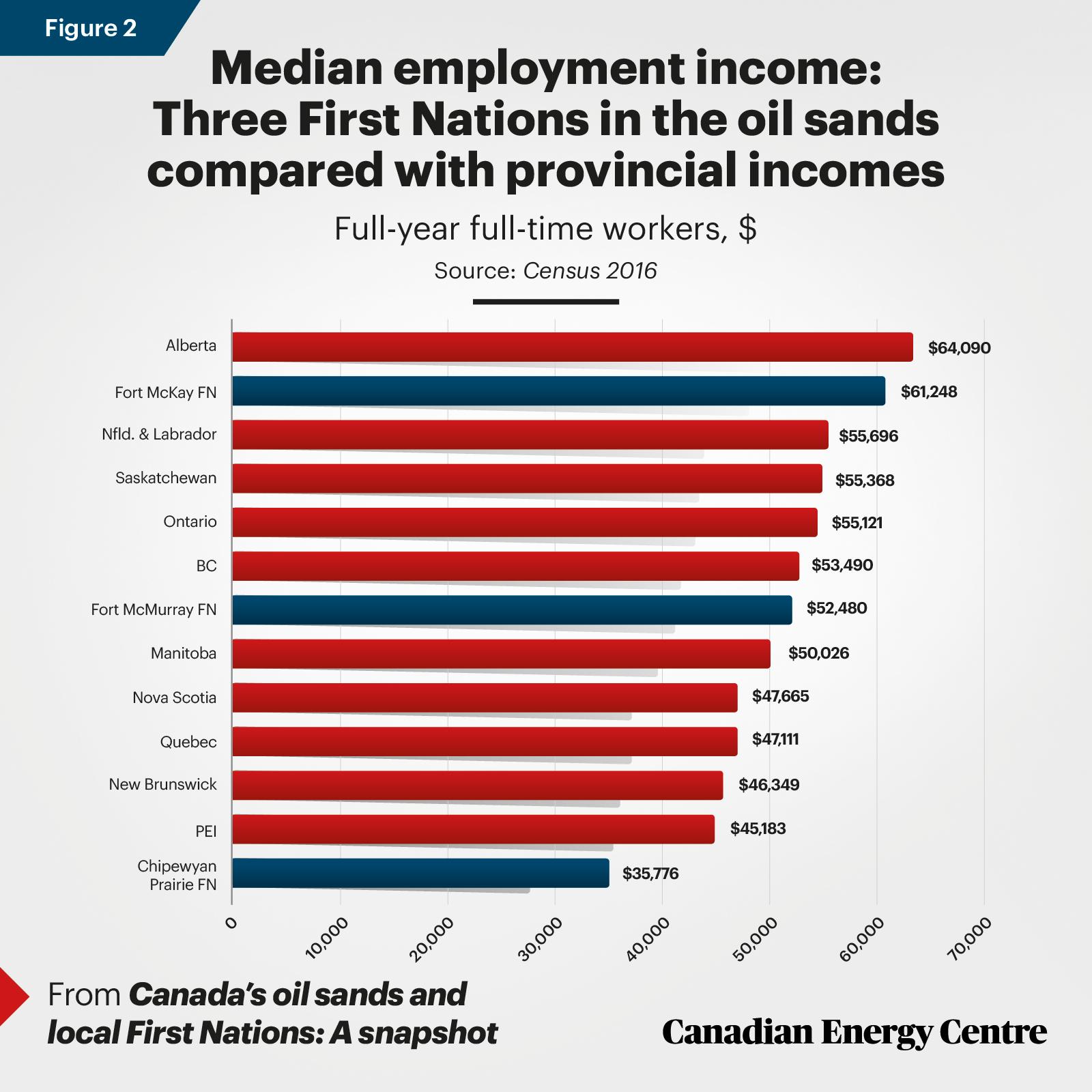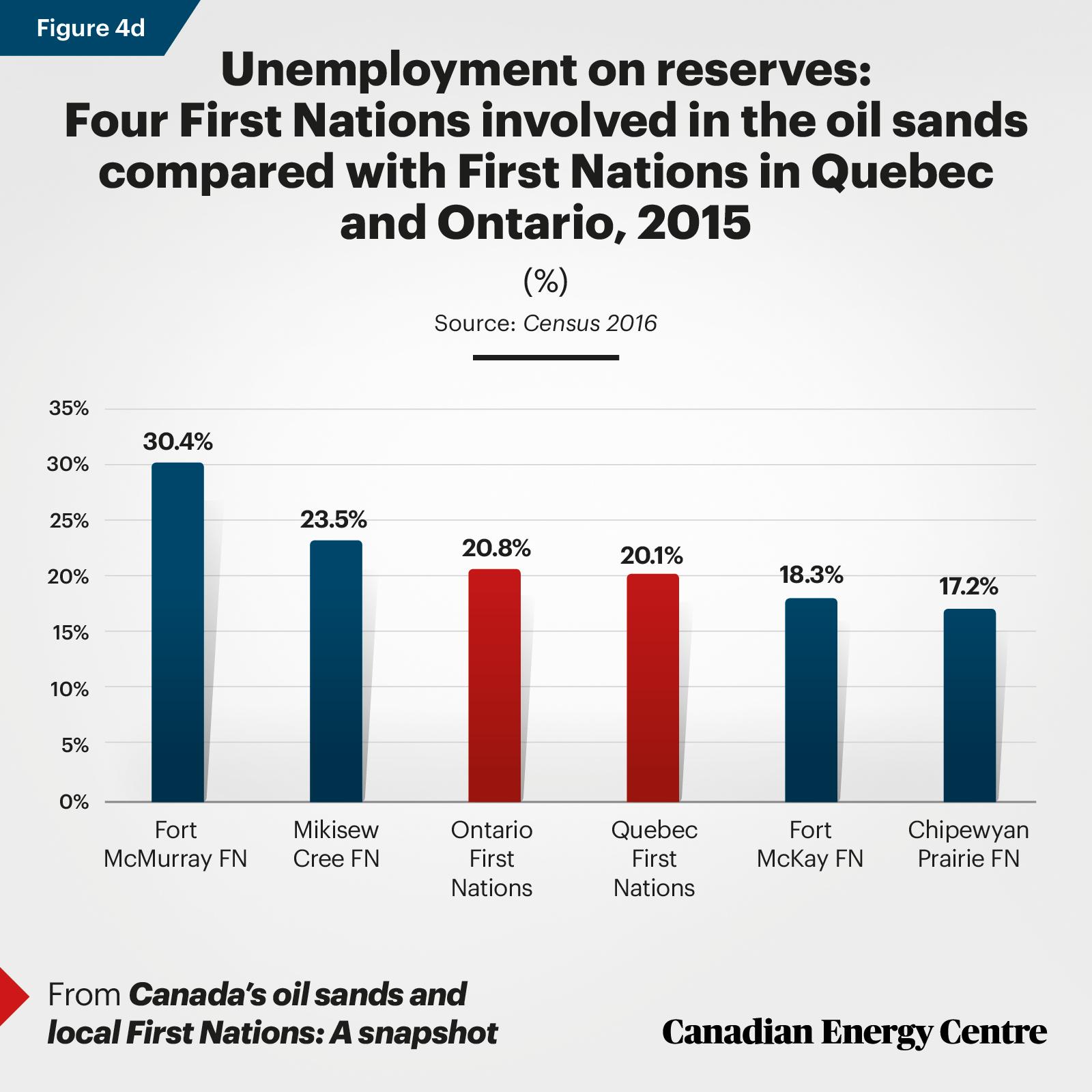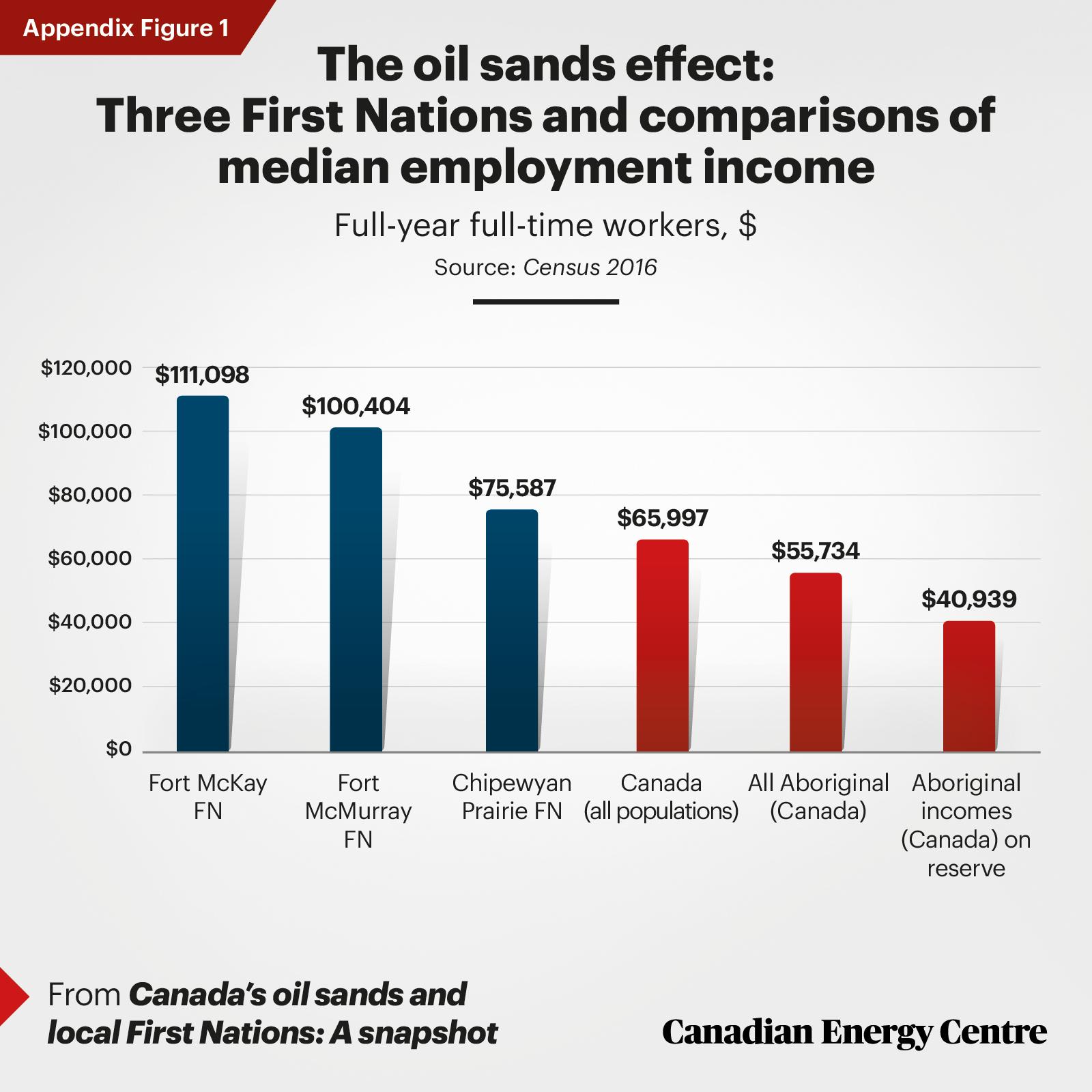First Nations involved in Canada’s oil sands industry experience significant and profound positive economic effects, finds a new research brief by the Canadian Energy Centre.
Using Statistics Canada data, the brief highlights four First Nations communities in the heart of the Alberta oil sands: Chipewyan Prairie First Nation, Fort McKay First Nation, Fort McMurray First Nation and Mikisew Cree First Nation.
These communities are typical of many First Nations reserves across rural and northern Canada, where Aboriginal communities are often far from major urban centres and where employment and income opportunities are, in many instances, relatively scarce.
However, the economic outcomes for the First Nations involved in the oil sands are atypical, with all four profiled First Nations recording less dependency on government transfers, lower unemployment, and higher incomes. (The entire research brief can be found and downloaded here)
Five snapshots of First Nations success in the oil sands

Snapshot One: Involvement in the oil sands has allowed First Nations to earn incomes higher than the median incomes for all First Nations across Canada and the general population
Fact: One First Nation, Fort McKay, which is significantly involved in the oil sands, shows a median employment income of $61,248—over $7,800 higher than the equivalent figure for all Canadians ($53,431). The median employment income in Fort McKay is also higher than that for all citizens in nine of ten provinces.
Three of the First Nations (Fort McKay, Fort McMurray, and Chipewyan Prairie) show median employment incomes above those for all reserves in Canada ($35,676), though Chipewyan Prairie First Nation at $35,776 is only marginally above the Canada-wide median.

Snapshot Two: One First Nation involved in the oil sands shows median employment income higher than nine of ten provinces
Fact: The median employment income for Fort McKay First Nation ($61,248) exceeds that for every province except Alberta ($64,090). Fort McMurray First Nation shows a median income ($52,480) above those of five provinces (Manitoba, Nova Scotia, Quebec, New Brunswick and Prince Edward Island).

Snapshot Three: Aboriginal Canadians employed in pipeline transportation and oil and gas extraction show median employment incomes that are significantly higher than in other industries.
Fact: Median employment income for those of Aboriginal ancestry who work in oil and gas extraction and in pipeline transportation is $144,034 and $142,883 respectively. That is significantly higher than the median employment income for those of Aboriginal ancestry employed in the motor vehicle manufacturing ($78,019) and aerospace products and parts manufacturing ($64,631) sectors.

Snapshot Four: Aboriginal Canadians are employed in far higher proportions in the energy sector than in other industries.
Fact: Self-identified Aboriginal Canadians make up 5.2% of those employed in oil and gas extraction and 3.8% of the workforce in pipeline transportation. In comparison, the proportion of self-identified Aboriginal Canadians employed in the motor vehicle manufacturing sector is 2.5% while in the aerospace products and parts manufacturing sector it is 1.5%.

Snapshot Five: First Nations with significant involvement in the oil sands are less dependent on government transfers than residents in most provinces.
Fact: Residents of Fort McKay First Nation—one of the most successful First Nations in the oil sands—are less dependent on government transfers ($4,224) than non-Aboriginal residents in eight provinces: British Columbia, Saskatchewan, Manitoba, Quebec, Nova Scotia, New Brunswick, Prince Edward Island, and Newfoundland & Labrador. The median government transfer in those eight provinces ranges from $4,324 in Manitoba to $9,306 in Newfoundland & Labrador.
Introduction: An overview of the oil sands, four First Nations, and local indigenous prosperity
Canada’s oil sands, located in northern Alberta, are the third-largest proven oil reserves in the world. As Natural Resources Canada (undated) notes, the oil deposits therein represent 97% of Canada’s 171 billion barrels of proven oil reserves.
Beyond the size of the resource, the local economic effect is also significant, particularly for indigenous Canadians who have seen pronounced positive effects on their employment and unemployment rates, employment income, and government transfers.
Many issues affect investment in and policy discussions of the oil sands, from environmental considerations to the wider economic impact upon the Canadian economy. As those issues have been discussed at length elsewhere, they will not be addressed in this Brief, which instead aims to highlight one often-overlooked cohort in such discussions: local First Nations and the local economic impact of Canada’s oil sands as it relates to those same Indigenous communities.
This Brief will rely on Statistics Canada data (Statistics Canada, 2018) compiled from the 2016 federal census. Specifically, it will profile four First Nations located in the Regional Municipality of Wood Buffalo (RMWB) in the heart of the oil sands whose involvement in the oil sands dates back to the 1980s in some cases (For ease of reference and in the figures each First Nation will be referred to in abbreviated form).
They are:
• Chipewyan Prairie First Nation
• Fort McKay Indian Settlement
• Fort McMurray #468 First Nation
• Mikisew Cree First Nation
We profile the four selected with measurements of employment income (median, full-time, full-year) unemployment rates, employment income by industry, employment as a proportion of major industries, and government transfers. (Of note, 2016 census employment income data for Mikisew Cree are not available and thus are excluded from that comparison.) The data from these four First Nations are then compared with:
• First Nations reserves across Canada, all of Canada (all citizens), and by region This provides an apples-to-apples comparison, i.e., on-reserve median employment incomes and unemployment rates. This is useful because the census data are clear that off-reserve First Nations people have higher median employment incomes than on-reserve First Nations people. For investors, policymakers, and the public, it is useful to know about the on-reserve outliers, i.e., First Nations located in the main oil sands region where the data, with rare exceptions, demonstrate higher median incomes and lower unemployment rates than in other First Nations.
• Aboriginal income and involvement by major industryThe industries for which we have data on First Nations involvement include pipeline transportation, oil and gas extraction, motor vehicle manufacturing, aerospace products and parts manufacturing, and the catch-all “all industries.” These data are relevant because many investors, policymakers, and the general public may be unaware of the participation in and benefits from each sector to indigenous Canadians.
• Government transfers to the general population, by provinceThis is a useful measurement because, as the reader will observe, all four First Nations involved in the oil sands receive lower average transfers per person than non-Aboriginal citizens in five of the ten provinces. 1. For ease of reference and in the figures each First Nation will be referred to in abbreviated form.
Such comparisons matter: The four First Nations most heavily involved in the oil sands are typical of many First Nations communities (reserves) across Canada in this sense: they are rural, northern, and far from major urban centres.
For example, while the medium-sized urban centre of Fort McMurray is located within the Regional Municipality of Wood Buffalo, both it and one of the most successful First Nations in the oil sands region, Fort McKay, are far from the nearest major urban centre, Edmonton. (Fort McMurray and Fort McKay are, respectively, 430 kilometres and 500 kilometres from Edmonton.)
However, the profiled four First Nations involved in the oil sands have atypical economic outcomes compared with the averages of First Nations across Canada. For all four, at least some of their economic indicators are higher (median employment incomes) and lower (unemployment rates and dependency on governments transfers) than not only other First Nations Canada-wide, but relative to all citizens in multiple provinces. In specific, the oil sands economy has a significant positive economic impact on local indigenous communities. In general, indigenous involvement in oil and gas extraction and pipelines correlates positively with less dependency on government transfers, lower unemployment, and higher incomes.
A more detailed comparison

Three First Nations and median employment income comparisons
Figure 1 compares median employment income¹ for the profiled First Nations, for all who self-identified as Aboriginal, and for First Nations reserves across Canada². The 2016 census data show that:
• One First Nation, Fort McKay, has a higher median income ($61,248) than Canadians at large ($53,431).
• Two of the other First Nations in the oil sands region (Fort McMurray and Chipewyan Prairie) have median incomes ($52,480 and $35,776, respectively) higher than the median for First Nations communities Canada-wide ($35,676, all Aboriginal cohorts), though only slightly higher in the case of the Chipewyan First Nation.
1. From Statistics Canada: The median income of a specified group is the amount that divides the income distribution of that group into two halves, i.e., the incomes of half of the units in that group are below the median, while those of the other half are above the median.
2. In all the census data displayed in Figure 1, median employment income results are restricted to those who work all year and full time. This allows for an “apple-to-apple” comparison across sample cohorts, i.e., the reported Aboriginal incomes on reserve (in Canada) are for those employed throughout the year and who work full-time hours. The same is applicable to the data for all populations in Canada, Fort McKay First Nation, and the other profiled cohorts.

Median employment income: Comparison with the provinces
Figure 2 compares three Wood Buffalo region First Nations (with available data) on median employment income (full-year, full-time) to all provinces.
• The median income for Fort McKay First Nation ($61,248) exceeds that for every province except Alberta ($64,090).
• Fort McMurray First Nation has a median income ($52,480) above that in five provinces (Manitoba, Nova Scotia, Quebec, New Brunswick, and Prince Edward Island).
• The median income in the Chipewyan First Nation is below that of the other three First Nations and the ten provinces.

Median employment income by industry
Figure 3a shows median employment income (full-year, full-time) by industry for those who self-identified in the 2016 census as Aboriginal.
• Median employment income for those of Aboriginal ancestry who work in oil and gas extraction and in pipeline transportation ($144,034 and $142,883, respectively) is significantly higher than the median employment income of those of Aboriginal ancestry working in the motor vehicle manufacturing ($78,019) and aerospace products and parts manufacturing ($64,631).

Aboriginal participation in Canada’s energy sector compared with other industries
On a related note, another economic indicator that demonstrates the impact of an industry on a local economy or community is that community’s employment participation. Figure 3b shows the proportion of self-identified Aboriginal Canadians working in various industries.
• An average of 3.9% of self-identified Aboriginal Canadians are employed in all industries.
• The percentage of self-identified Aboriginal Canadians employed in oil and gas extraction (5.2%) and pipeline transportation (3.8%) is significantly higher than the proportion employed in the motor vehicle manufacturing sector (2.5%) and the aerospace products and parts manufacturing sector (1.5%).
• The percentage of Aboriginal Canadians employed in oil and gas extraction (5.2%) is above the national average for all industries (3.9%)
• The percentage of Aboriginal Canadians employed in the motor vehicle manufacturing sector and aerospace products and parts manufacturing sector (2.5% and 1.5% respectively) is below the national average for all industries.

Unemployment and the oil sands effect: Four First Nations involved in the oil sands compared with all First Nations
Figure 4a compares the unemployment rates among four First Nations involved in the oil sands to the average unemployment rate Canada-wide for all on-reserve Aboriginal Canadians.
• A caveat: The 2016 census data are based on 2015 data. The price of oil declined dramatically in the last quarter of 2014 and into 2015 with a resulting slump in employment that is dependent on that resource.



Unemployment in Canada’s First Nations by region compared with four involved in the oil sands
Figures 4b, 4c, and 4d compare the unemployment rates for four First Nations involved in the oil sands with the First Nations averages grouped by region: Western Canada, Atlantic Canada, and Central Canada.
• Chipewyan Prairie and Fort McKay have lower unemployment rates than average First Nations rates nationwide
• Apart from Fort McMurray, the other three profiled First Nations have unemployment rates lower than the regional average of most other First Nations. The exceptions are in Newfoundland & Labrador and Prince Edward Island, where the First Nations have higher unemployment rates than Fort McMurray First Nation.

Dependency on government transfers: Three First Nations involved in the oil sands compared with the provinces
Transfers from governments to people³ can be an indicator of the strength or weakness of a region’s economy, including the ability of its citizens to earn employment income.
• Figure 5a looks at government transfers to the three First Nations involved in the oil sands for which data are available. Two of the three (Fort McMurray at $5,040 and Fort McKay at $4,224) receive government transfers that are less than the median transfer for First Nations reserves nationwide ($5,394).
3. Statistics Canada defines government transfers as all cash benefits received from federal, provincial, territorial, or municipal governments during the reference period. It includes Old Age Security pension, Guaranteed Income Supplement, Allowance or Allowance for the Survivor; retirement, disability and survivor benefits from Canada Pension Plan and Québec Pension Plan; benefits from Employment Insurance and the Québec parental insurance plan; child benefits from federal and provincial programs; social assistance benefits; workers’ compensation benefits; Working income tax benefit; Goods and services tax credit and harmonized sales tax credit; and other income from government sources.

• Figure 5b compares government transfers to the three First Nations involved in the oil sands for which data are available with the provinces
°All of the profiled First Nations are less dependent on government transfers than citizens in five provinces: Newfoundland & Labrador, Prince Edward Island, New Brunswick, Nova Scotia, and Quebec. The median government transfer to three First Nations involved in the oil sands ranges from $4,224 to $6,096. That range is below the median government transfer in the five most-dependent provinces, where the figures range from $7,301 (Quebec) to $9,309 (Newfoundland & Labrador).
°Residents of Fort McKay First Nation—one of the most successful First Nations involved in the oil sands—are less dependent on government transfers ($4,224 is the median) than residents of eight Canadian provinces. Only residents in Alberta ($4,079) and Ontario ($4,172) are less dependent on government transfers.
Summary
Policy decisions on resource development are the purview of governments and those elected to public office. The general purpose of CEC Research Briefs is to provide statistical ‘snapshots’ to give context on energy issues for investors, policymakers, and the public. The aim of this specific Brief is to profile four First Nations with significant involvement in the oil sands. For context, the Brief uses census data to compare those four with other First Nations in Canada and with other cohorts. In specific, the economic effect of the oil sands is significant for indigenous Canadians involved in the local oil sands economy. The oil sands industry has had a pronounced positive effect upon their employment and unemployment rates, employment income, and on their reliance on government transfers. In general, indigenous involvement in oil and gas extraction and pipelines correlate positively with less dependency on government transfers, lower unemployment, and higher incomes.
Appendix: Average incomes and employment rates
The following data are provided for additional context on selected Wood Buffalo-area First Nations. Note that the statistics can be skewed dramatically higher or lower by data outliers in the measured community. Nevertheless, even outliers and the resulting averages are another indicator of opportunities (or the lack thereof) among the First Nations in this data set, located in the oil sands region.

Average incomes: Three First Nations compared with all citizens of Canada and with all Aboriginal people in Canada on-reserve
Data from the 2016 census are available on the average employment income of three of four First Nations located within the Regional Municipality of Wood Buffalo. Beyond the already-detailed median incomes⁴, average incomes are another way to compare the economic impact of the oil sands on Indigenous Canadians and communities in the oil sands. Of note, the three compared First Nation reserves in
Appendix Figure 1 all record higher average incomes than the Canadian average, the Canada-wide average for all Aboriginal Canadians, and for those who live on reserve.
4. From Statistics Canada: Average income of a specified group is calculated by dividing the aggregate income of that group by the number of units in that group. Average incomes of individuals are calculated for those with income (positive or negative).

Comparing the average incomes of three First Nations and ten provinces
Appendix Figure 2 compares the average and median incomes for the three First Nations most involved in the oil sands with the incomes of all citizens in all provinces.
• The average incomes (Appendix Figure 2) for the Fort McKay and Fort McMurray First Nations exceed those for all provinces, including the province with the highest average income (Alberta), while the average income for the Chipewyan First Nation exceeds that in the nine remaining provinces.

Comparing employment rates
Appendix Figure 3 compares employment rates for the four First Nations involved in the oil sands with the Canadian
average for all First Nations reserves.
• Three of the four First Nations profiled (Fort McKay, Mikisew Cree, and Chipewyan Prairie) have employment rates that are higher than the national average for those identifying as Aboriginal. One (Fort McMurray) has a rate equal to the national average (Appendix Figure 3).
Sources
Fort McKay Group of Companies (Undated). Company History. Fort McKay Group of Companies, as of February 17, 2020.
Natural Resources Canada (Undated). What Are the Oil Sands? Government of Canada, as of February 17, 2020.
Statistics Canada (2018). Aboriginal Population Profile. 2016 Census. Catalogue no. 98-510-X2016001. Statistics Canada, as of February 17, 2020.
Statistics Canada (2018). Athabasca Tribal Council Ltd. [First Nation/Indian band or Tribal Council area], Alberta (table). Aboriginal Population Profile. 2016 Census. Catalogue no. 98-510-X2016001. Statistics Canada.
Statistics Canada (2018). Chipewyan Prairie First Nation [First Nation/Indian band or Tribal Council area], Alberta (table). Aboriginal Population Profile. 2016 Census. Catalogue no. 98-510-X2016001. Statistics Canada.
Statistics Canada (2018). Fort McKay First Nation [First Nation/Indian band or Tribal Council area], Alberta (table), Aboriginal Population Profile. 2016 Census. Catalogue no. 98-510-X2016001. Statistics Canada.
Statistics Canada (2018). Fort McMurray #468 First Nation [First Nation/Indian band or Tribal Council area], Alberta (table), Aboriginal Population Profile. 2016 Census. Catalogue no. 98-510-X2016001. Statistics Canada.
Statistics Canada (2018). Mikisew Cree First Nation [First Nation/Indian band or Tribal Council area], Alberta (table), Aboriginal Population Profile. 2016 Census. Catalogue no. 98-510-X2016001. Statistics Canada.
Statistics Canada (2018). Canada [Country] (table). Aboriginal Population Profile 2016 Census. Catalogue no. 98-510-X2016001. Statistics Canada.
Statistics Canada (2018). (Various provinces.) Aboriginal Population Profile (table). 2016 Census. Catalogue no. 98-510-X2016001. Statistics Canada.
Statistics Canada (2016). 2016 Census of Population. Catalogue no. 98- 400-X2016359. Statistics Canada, as of February 17, 2020.
